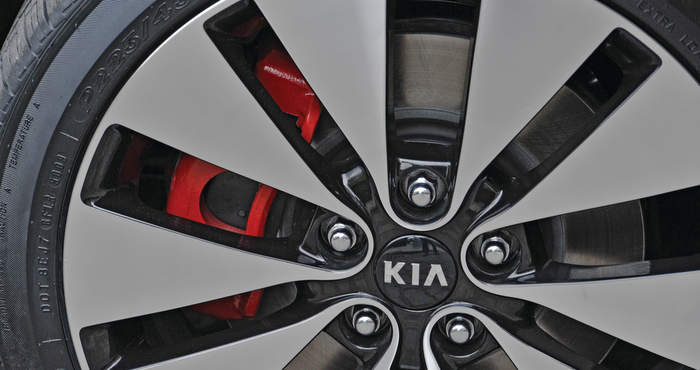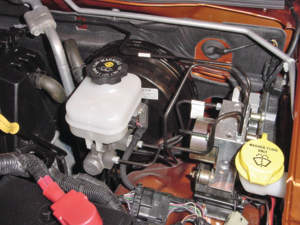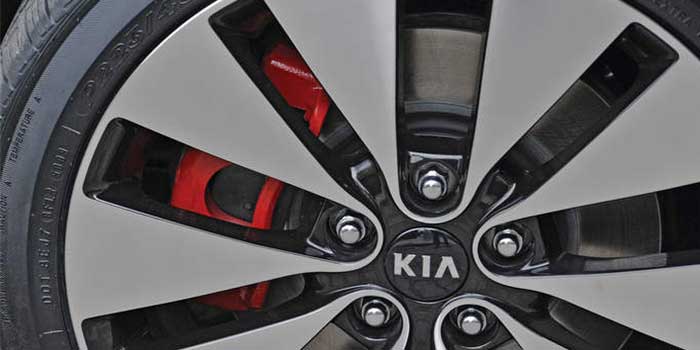
Kias will provide little challenge for any tech currently handling basic brake work. All it takes is paying attention to details and good work habits to make it profitable.
An occasional long pedal could be a master cylinder bleeding down, which usually happens in a stop-and-go or a downhill situation where the brakes are being used. Or, it could also be the fluid heating after a run on the interstate, making the pedal fade as a result of the brakes binding. Knowing when the problem occurs will not only save you some time, but also avoid a misdiagnosis.
If a Kia comes in with a grinding problem, the next step is to look for uneven wear. If one wheel is showing more wear than the other on that axle, it’s time to do some investigating. The most likely cause of unexpected wear is a caliper or hardware issue, and the key to a successful job is figuring out the true culprit.
 Now, before you jump to the conclusion that you have a frozen caliper, take a couple of minutes to confirm the diagnosis and look at the rest of the system so you can give the customer an accurate estimate and get all the parts you need in one call. The nuts and bolts of brake replacement are familiar to us all, but it never hurts to review the basics.
Now, before you jump to the conclusion that you have a frozen caliper, take a couple of minutes to confirm the diagnosis and look at the rest of the system so you can give the customer an accurate estimate and get all the parts you need in one call. The nuts and bolts of brake replacement are familiar to us all, but it never hurts to review the basics.
Confirm what is causing the brake to drag. Before pushing the caliper pistons back, attach your bleed bottle and open the bleeders so that you’re not pushing the most contaminated fluid back up through the dirt-sensitive Kia ABS unit. With the calipers off the brackets, continue to look for issues that could be causing the uneven wear problem. If the caliper pistons move freely and the boots are in good shape, turn your attention to the sliders and pad movement. If you find nothing dragging on the worn side, double-check the other wheels for binding that’s preventing that caliper from doing its fair share of the work. Usually pad wear patterns will indicate this kind of problem.
You can and should prevent these problems by using good work habits when performing any brake service. When you’re replacing friction material, take the time to clean and protect the surface of the caliper bracket that makes contact with the pads. Be sure to remove the anti-rattle hardware to get rid of any rust that may have built up under these parts. Remove, clean and lubricate the sliders to ensure a good, solid brake pedal, as well as an ABS system that will function as designed.
Any car that went metal-to-metal would be getting rotors depending on the depth of the scoring, and Kias are no exception. It’s common to have a solid buildup of rust and corrosion on the non-friction area of the rotor, and for the low cost involved for replacement, risking noise or a vibration comeback doesn’t make sense.
Take the time to clean up the hub so you’re not risking knocking that new rotor out of true.
HYDRAULICS AND ABS
One thing that could lead to excessive wear that we haven’t talked about is a hydraulic problem. While certainly not a common problem on Kias, it’s possible that you could encounter a situation where there is pressure in the line when the pedal isn’t depressed. This could be caused by too little clearance in the master cylinder push rod, but this problem usually shows up only after the vehicle is driven and the brake fluid heats up. Or, a brake hose with an internal failure might be acting like a one-way valve holding pressure at the caliper.
Any of these problems are easy to diagnose if they can be duplicated. To confirm the hydraulic system is the problem and to help pinpoint where the problem is located, firmly apply and release the brakes to put pressure in the system and work backward from the caliper, loosening connections to find the restriction.
When inspecting the rear brakes, again, be sure everything is operating freely. Many Kias are equipped with rear drum brakes; don’t overlook the rear wheel cylinders for smooth operation — that’s critical. If the shoes are good, there’s no reason to disassemble, but push on the pistons to be sure the cylinders aren’t frozen. If the shoes are worn, don’t forget those good work habits and be sure to free up and lube the contact areas of the backing plate, as well as all the adjustment and handbrake hardware.
Beyond the mechanical aspects of undercar service, Kia certainly hasn’t been standing still when it comes to the electronic aspect of undercar improvements. ABS has been in use for years, while late-model vehicles are equipped with electronic stability control (ESC).
This system uses wheel speed, brake and steering inputs as well as vehicle yaw and lateral acceleration to assist the driver. We don’t have time to cover these systems in this article, but it’s important that your shop makes the investment necessary to be able to diagnose these systems. It will require a scanner that has the enhanced capabilities needed to access these systems. While the factory tools would be ideal, there are other options available that will give you access to a variety of vehicles.
With these tools becoming more affordable, there is just no reason for your shop not to have one. If you’re looking for more information on these systems, just point your browser to Kia’s technical info website at www.kiatechinfo.com. There is no charge to register, and you’ll find a wealth of information on the site. Kia wants us to be able to repair its cars; there’s no reason we shouldn’t take advantage of that.
Access to good, quality information to service Kias with greater precision is good news for you and your customers.
Courtesy Brake & Front End.














